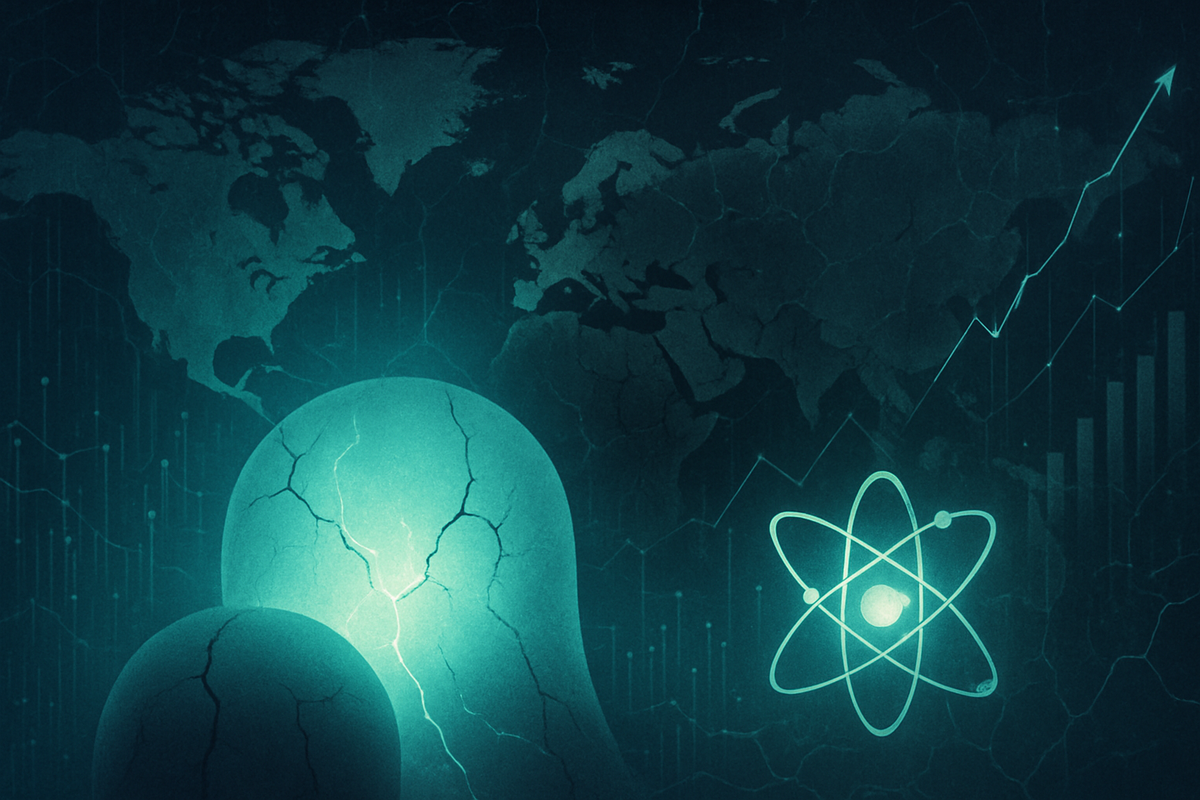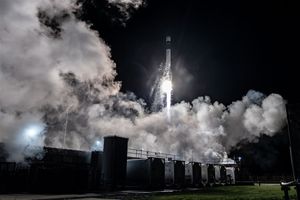
The global energy landscape is bracing for a potential crisis in 2025, fueled significantly by a deepening and structural supply shortfall in the uranium market. As of October 2025, annual global nuclear reactor demand for uranium far outstrips primary mining production, creating a persistent deficit that experts warn could exacerbate energy instability worldwide. This imbalance, driven by years of underinvestment and exacerbated by geopolitical tensions and surging new demand from sectors like Artificial Intelligence, is sending uranium prices soaring and forcing nuclear utilities into an unprecedented "contracting crisis."
This critical deficit, estimated at around 50 million pounds annually against a demand of 180 million pounds, is not a cyclical blip but the culmination of a decade-long period of depressed prices that stifled exploration and development. With secondary stockpiles largely depleted, the market's reliance on primary production has exposed its inherent vulnerabilities. The immediate implications are severe: uranium spot prices have surged to over $83 per pound in early October 2025, with forecasts predicting further increases. Nuclear power generators face immense pressure to secure fuel for their future operations, a challenge that directly impacts their ability to provide stable, carbon-free baseload power and threatens to undermine global energy security initiatives.
A Decade of Underinvestment Culminates in Critical Shortage
The current uranium supply crunch is the result of a protracted period of market neglect and strategic missteps. Following the Fukushima disaster in 2011, uranium prices plummeted and remained low for nearly a decade, rendering many mining operations uneconomical and discouraging investment in new projects. This led to the closure of significant mines, such as Ranger in Australia and Cominak in Niger, and a severe lack of new development, creating a substantial gap in the supply pipeline that cannot be quickly rectified. The inherent lead time for bringing a new uranium mine online—typically 10-15 years from exploration to production—means that even with current rising prices, new supply will not alleviate the near-term deficit.
Adding to the supply woes, a significant portion of global uranium production is concentrated in a few key regions, most notably Kazakhstan, which accounts for approximately 43% of the world's output. Geopolitical events, including ongoing sanctions affecting Russian supply and recent instability in Niger, have highlighted the fragility of this concentrated supply chain and underscored the urgent need for diversification. Beyond mining, bottlenecks persist in the midstream nuclear fuel cycle, specifically in uranium conversion and enrichment capacity. Western conversion facilities are operating near maximum capacity, and global enrichment capacity is projected to fall significantly short of demand by 2034. Russia's substantial share (around 40%) in global enrichment services presents a strategic vulnerability for Western economies, reminiscent of Europe's past reliance on Russian natural gas.
As of October 2025, nuclear utilities are confronting a severe "procurement crisis." An estimated 25-30% of their 2025 uranium requirements, and even higher percentages for subsequent years, remain uncontracted. This forces them into a volatile spot market or into signing long-term contracts at substantially higher prices, directly impacting their operational costs and the stability of electricity grids. In response, utilities are adapting by pursuing longer-term contracts (7-10 years) and actively diversifying their uranium sources. Governments are also taking action; the U.S. Department of Energy (DOE) held the first meeting of its Defense Production Act (DPA) Consortium on October 14, 2025, aimed at bolstering domestic nuclear fuel supply and reducing reliance on foreign imports. This coordinated effort signifies the growing recognition of nuclear energy's critical role in national security and decarbonization goals.
Market Winners and Losers Amidst the Uranium Squeeze
The escalating uranium supply shortfall is creating a distinct bifurcation in the financial markets, with certain companies poised for significant gains while others face considerable headwinds.
Uranium Producers and Developers are the clear beneficiaries of the surging prices and long-term demand outlook. Major players like Cameco Corporation (NYSE: CCJ, TSX: CCO), one of the world's largest uranium producers, stand to see substantial increases in revenue and profitability as existing contracts roll off and new ones are signed at much higher rates. Similarly, Kazatomprom (LSE: KAP), the state-owned uranium producer of Kazakhstan and the world's largest, is benefiting from the robust market, although it recently announced a 10% output cut for 2026, further tightening supply. Junior uranium miners and developers, such as Energy Fuels Inc. (NYSE: UUUU, TSX: EFR) and Denison Mines Corp. (NYSE: DNN, TSX: DML), are also experiencing renewed investor interest and improved prospects for financing new projects, as higher prices make previously uneconomical deposits viable. Investment vehicles like the Sprott Physical Uranium Trust (TSX: U.UN, OTCQX: SRUUF), which holds physical uranium, have seen significant appreciation as a direct proxy for the rising commodity price, attracting substantial capital inflows. These companies are positioned to capitalize on the multi-year structural deficit, as the incentive price for new production continues to climb.
Conversely, Nuclear Power Utilities face the immediate challenge of securing adequate and affordable fuel supplies. Companies operating nuclear reactors, such as Constellation Energy Corporation (NASDAQ: CEG) in the U.S. or Electricité de France (EDF) in Europe, will see their operational costs rise significantly as they are forced to contract for uranium at elevated prices. While nuclear power remains a cost-effective and reliable source of baseload electricity, a prolonged period of high uranium prices could squeeze profit margins, potentially impacting their ability to invest in upgrades or new reactor construction. This "contracting crisis" forces utilities to make difficult decisions between spot market volatility and long-term commitments at historically high prices. Furthermore, companies involved in uranium conversion and enrichment, such as Urenco (privately held but impacts utilities), will also experience increased demand, though capacity constraints in this segment mean that even if more uranium ore is mined, bottlenecks in processing could still limit the availability of usable fuel, affecting all downstream users.
Broader Implications and the Nuclear Renaissance
The uranium supply shortfall extends far beyond the immediate financial performance of individual companies, touching upon broader industry trends, geopolitical strategies, and the global energy transition. This event is unfolding against the backdrop of a burgeoning "nuclear renaissance," where nuclear power is increasingly recognized as a critical component for achieving energy security and aggressive decarbonization targets. Thirty-one countries have pledged to triple nuclear power capacity by 2050, making a reliable uranium supply paramount.
The crisis highlights the inherent vulnerabilities of concentrated supply chains, echoing past energy shocks. Europe's recent energy crisis, driven by its dependence on Russian natural gas, serves as a stark reminder of the risks associated with relying on a single or limited set of suppliers for critical energy resources. The current reliance on Kazakhstan for uranium mining and Russia for enrichment services presents similar strategic challenges for Western nations. This situation is prompting governments and utilities to actively seek diversification and invest in domestic capabilities, as exemplified by the U.S. Department of Energy's DPA Consortium.
A significant new demand driver exacerbating the uranium squeeze is the exponential growth in Artificial Intelligence (AI) and data centers. These energy-intensive operations require vast amounts of stable, always-on power. Experts project AI could add 9% to global electricity demand by 2030, with major tech giants like Microsoft Corporation (NASDAQ: MSFT), Alphabet Inc. (NASDAQ: GOOGL), Amazon.com, Inc. (NASDAQ: AMZN), and Meta Platforms, Inc. (NASDAQ: META) actively pursuing nuclear power solutions to fuel their operations. Nuclear energy's capacity for continuous, carbon-free baseload generation makes it an ideal fit for these demands, intensifying the pressure on an already constrained uranium market and further solidifying its role in the broader energy transition.
Navigating the Future: What Comes Next
The uranium market is entering a transformative period, with significant short-term and long-term implications for global energy security and investment. In the short term, continued upward pressure on uranium prices is highly probable. Analysts widely forecast prices to reach $90-$100 per pound by mid-to-late 2025, with some projections extending to $135 per pound by 2026 or even higher under accelerated demand scenarios. This sustained price appreciation is crucial to incentivize new mining projects and attract the necessary capital for exploration and development. However, due to the long lead times for bringing new supply online, the structural deficit is expected to persist for several years, creating a challenging environment for nuclear utilities.
Strategically, utilities will likely continue to pivot towards longer-term contracts, accepting higher prices to de-risk their fuel supply. This shift will provide greater revenue visibility for producers and stimulate investment in capacity expansion across the entire nuclear fuel cycle, including conversion and enrichment. Governments, particularly in the U.S. and Europe, are expected to intensify efforts to establish strategic uranium stockpiles and invest in domestic or allied fuel cycle infrastructure to reduce geopolitical dependencies. This could manifest in direct government funding, subsidies, or favorable regulatory environments for domestic producers.
Market opportunities will emerge not only in uranium mining but also in related sectors such as nuclear reactor technology development (e.g., Small Modular Reactors or SMRs), fuel fabrication, and even advanced energy storage solutions that can complement nuclear power. Challenges will include navigating the complex regulatory landscape for new mine permitting, managing environmental and social governance (ESG) considerations, and overcoming the significant capital requirements for new projects. The ability of the industry to scale up quickly enough to meet the rapidly accelerating demand, particularly from the AI sector, will be a defining factor in whether the 2025 energy crisis deepens or is mitigated. Investors should closely monitor policy developments, geopolitical shifts, and the progress of new mining and fuel cycle projects.
A Pivotal Moment for Global Energy
The uranium market supply shortfall represents a pivotal moment for global energy security and the ambitious goals of decarbonization. The structural deficit, born from a decade of underinvestment and now compounded by geopolitical risks and unprecedented demand from new sectors like AI, has thrust uranium into the spotlight as a critical commodity. The "contracting crisis" facing nuclear utilities and the soaring spot prices are clear indicators of a market in distress, yet also a market ripe with opportunity for those positioned to meet the growing demand.
Moving forward, the resilience and adaptability of the nuclear energy sector will be tested. The ability to secure stable and diverse uranium supplies, coupled with investments in the entire fuel cycle, will be crucial for nuclear power to fulfill its promise as a cornerstone of clean, reliable baseload electricity. Governments, producers, and utilities must collaborate to de-risk the supply chain and accelerate new project development. Investors should pay close attention to the long-term contracting trends, the progress of new mine developments, and governmental policies aimed at bolstering domestic nuclear fuel infrastructure. The unfolding events in the uranium market will have lasting impacts on global energy prices, energy independence, and the trajectory of the world's transition to a sustainable energy future.
This content is intended for informational purposes only and is not financial advice





